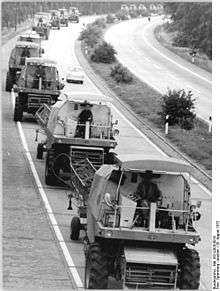Agriculture in East Germany
Agriculture in East Germany employed 10.8 percent of the labor force, received 7.4 percent of gross capital investments, and contributed 8.1 percent to the country's net product in 1985.[1] Farms were usually organized either in state-owned farms (Volkseigenes Gut) or collective farms (Landwirtschaftliche Produktionsgenossenschaft).

During the 1970s and early 1980s, the trend in East German agriculture was toward larger units; some crop-producing collectives and state farms combined to form cooperatives holding 4,000 to 5,000 hectares. These agribusinesses, known as Cooperative Departments of Crop Production (Kooperative Abteilungen der Pflanzenproduktion--KAP), which included foodprocessing establishments, became the dominant form of agricultural enterprise in crop production. In the early 1980s, specialization also took place in livestock production.[2]
References
| Wikimedia Commons has media related to Agriculture in the German Democratic Republic. |
- Encarta Encyclopedia, Official Statistics
- Mongbay, East Germany-Agriculture